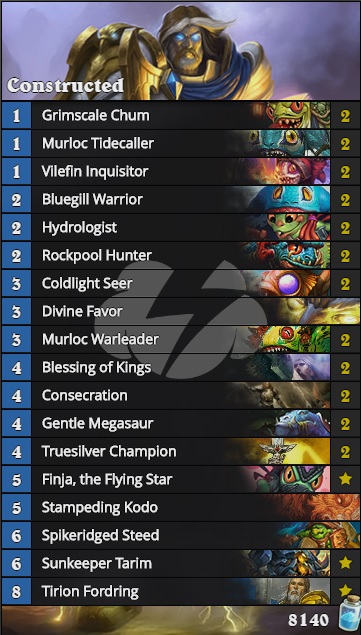Hearthstone’s meta has been slowly settling over the past several weeks. As the new Journey to Un’Goro decks become more refined, they’re bound to move around a few ranks. Normally, however, we don’t see drastic changes–a deck might move up or down a couple spots in a week, but overall, it’s fair to say that Hearthstone’s meta develops at a fairly slow pace. This week, two Paladin decks defied convention and climbed all the way from the bottom of the garbage heap to the top of almost every tier one deck list.
Paladin’s delayed arrival to Hearthstone’s metagame is due to several factors. First, Paladin’s Quest turned out to be awful, which meant that early Paladin experimentation fell flat. Second, if we’re being honest, Paladin just isn’t that exciting to play. It’s not a class that the vast majority of players were willing to waste their dust on for the sake of experimentation, which is understandable.
It took a while before people recognized Paladin’s potential in Journey to Un’Goro. The fact that two separate decks got to tier one only goes to show how wrong everyone was–myself included. I thought Sunkeeper Tarim was terrible, but if you combine the card with some Murlocs, you can quickly become a force to be reckoned with.
Murloc Paladin Deck List

I did say that there were two Paladin decks that hit tier one, and technically, that is true. However, the two decks are far more similar than you might think. Both take the Murloc Paladin shell and work outwards. One deck takes an aggressive approach, using lots of small Murlocs and buffs. The other variant of this deck is focused on midrange, playing heavy hitters and/or controlling certain cards. The shells of the deck are almost identical–eighteen cards out of the thirty in each deck are the same.
With so many similarities, I wouldn’t be shocked if the two decks slowly merged together. If the community figures out a way to flesh out one of these deck shells properly to include the best of the other, we should be able to find the ‘optimal’ variant. Currently, the more aggressive version of the Paladin Murloc deck is doing slightly better, but, as we’ve noted before, faster decks tend to succeed more when the meta is still unresolved. Over the next few weeks, we anticipate Midrange Paladin Murloc to pull ahead.
It is interesting to note that despite having two tier one decks, Paladin remains of the least played classes in Hearthstone. At the end of last week, Vicious Syndicate reported that Paladin appeared in under 10% of ladder games. For context, you should note that Paladin is trailing far behind the other classes–Warrior is sitting at 22%, Hunter at 18%, and Rogue at 17%. While we’re looking at the stats, it’s nice to see that almost every class is doing well. Warlock has fallen on some hard times, showing up in only 2% of ladder games, but the others are all receiving quite a bit of play.
You May Like
Paladin Matchups
Midrange Paladin may be the absolute best class to have in tier one. The deck performs admirably against lots of opponents, but it almost never dominates. Midrange Paladin is truly a Jack of all trades, master of none. Of course, Midrange Paladin does excel against control decks in particular, and has lots of tools for dealing with aggressive decks. But the deck feels balanced — your wins with Midrange Paladin are earned, and your losses are deserved. That’s not always the case in Hearthstone. Midrange Paladin is a well-rounded deck that gives both players a chance, and I’m a huge fan.
Murloc Paladin is very similar, with a bit larger variance. Due to the aggressive nature of the deck, Murloc Paladin wins a bit harder in their strong matchups, which are mostly against midrange decks. Murloc Paladins also loses harder than Midrange Paladin in bad matchups, faring terribly against Taunt Warrior. Interestingly enough, the Midrange Paladin variant is more consistent, but the Murloc variant typically beats it.
Overall, I’d recommend the Midrange variant. It’s a strong deck, and, honestly, a refreshing change of pace. It’s nice to see strong decks in tier one that don’t completely dominate for once.
















